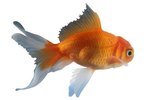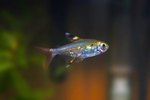
Angelfish, despite their name, are not very friendly toward other fish or even one another. If you're thinking of getting angelfish for your salt- or freshwater tank, research their needs as they need specific conditions in which to thrive. Angelfish are closely related to oscars and Jack Dempseys.
What's in a Name?
A rose by any other name is still a rose, but a saltwater angelfish and a freshwater angelfish are only distant cousins. Approximately 100 species of angelfish swim the oceans and lakes, and about 74 of these thrive in the sea. Saltwater tank aquarists may choose among much more colorful fish, which also grow larger than their freshwater cousins. The exact number of angelfish species is unknown because there are hundreds of possible gene combinations, creating many new mutations. Those keeping freshwater tanks are likely to find their choices limited to striped, black and white, silver or shades of yellow angelfish that grow to about 6 inches.
Personalities
Angelfish have distinct personalities. They are territorial in the presence of food, mates or eggs. If you're thinking of setting up a community tank, whether salt- or freshwater, use care in the selection of the other fish you place with angelfish. Since angelfish are little gluttons, they'll happily gobble up tossed-in food without a care in the world for the other fish in the tank who are hungry. Furthermore, they can be quite nasty and inflict wounds resulting in torn fins if placed in a tank with fish they perceive as a threat, such as bettas, fancy guppies or tetras. Zebra fish and other small, fast-moving fish are fine with angels as they can quickly get out of the way.
Cliques
Just like the cool kids who all sat together on the bus, angelfish form cliques. It's best to have an even number of angelfish so they can pair up. The odd angelfish is likely to be picked on or even killed. Angelfish need to be kept in very specific water, tank and temperature conditions, so they're not always the best starter fish. Since they are usually the size of a dime when purchased, novice fish-keepers often make the mistake of buying too many of them. They grow rapidly -- up to a diameter of 6 to 10 inches within 18 months, leading to overcrowding, a serious threat to the overall health and success of your tank.
Physical Characteristics
Angelfish are readily identified by the unusual, angular shape of their bodies. Saltwater angels can grow to a foot in diameter and are brightly colored and exotically patterned. Their dorsal and anal fins are slanted backwards instead of vertically, and their tails, also called caudal fins, are much smaller than those of the freshwater fish. Freshwater angelfish have tall vertical dorsal fins and long vertical anal fins. Their colors and patterns, while striking, are not as dramatic as those of the ocean angels. Both have long ventral fins that look like tendrils. The male angel's body is usually more circular than the female's, and there is a slight bump on his crown. The male's ventral fin is forked, whereas the female's is not. You'll note that the top-to-bottom stripes on the angelfish are not interrupted by their eyes; they appear as vertical lines on the fish's eyeball.
References
- A-Z Animals: Angelfish
- Fishbase: Family Pomacanthidae - Angelfishes
- Aquatic Community: Angelfish Genetics - Types of Angelfish
- Fishlore: Freshwater Angelfish - Pterophyllum Scalare
- Aquarium Guys: How to Care for Your Angelfish
- Love To Know Small Pets: 10 Facts About Angelfish
- Fishlore: Fish Anatomy
- Fish Zone: Difference Between Male and Female Angelfish
Photo Credits
-
Comstock Images/Comstock/Getty Images
Writer Bio
Michelle A. Rivera is the author of many books and articles. She attended the University of Missouri Animal Cruelty School and is certified with the Florida Animal Control Association. She is the executive director of her own nonprofit, Animals 101, Inc. Rivera is an animal-assisted therapist, humane educator, former shelter manager, rescue volunteer coordinator, dog trainer and veterinary technician.




